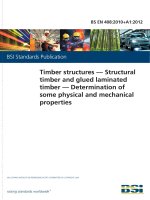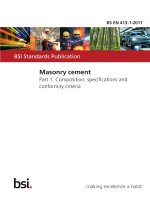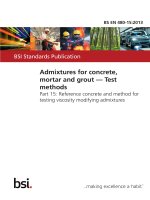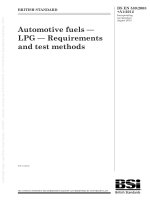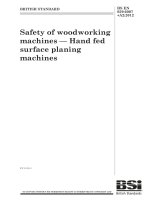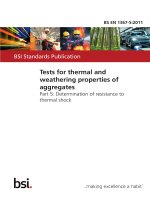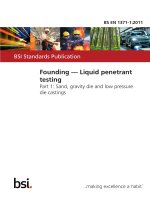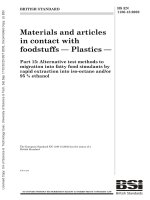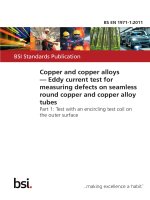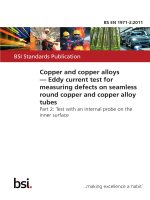Bsi bs en 61788 15 2011 (2012)
Bạn đang xem bản rút gọn của tài liệu. Xem và tải ngay bản đầy đủ của tài liệu tại đây (2.8 MB, 52 trang )
BS EN 61788-15:2011
Incorporating corrigendum March 2012
BSI Standards Publication
Superconductivity
Part 15: Electronic characteristic measurements
– Intrinsic surface impedance of superconductor
films at microwave frequencies
NO COPYING WITHOUT BSI PERMISSION EXCEPT AS PERMITTED BY COPYRIGHT LAW
raising standards worldwide™
BRITISH STANDARD
BS EN 61788-15:2011
National foreword
This British Standard is the UK implementation of EN 61788-15:2011.
It is identical to IEC 61788-15:2011.
The UK participation in its preparation was entrusted to Technical Committee
L/-/90 Super Conductivity.
A list of organizations represented on this committee can be obtained on
request to its secretary.
This publication does not purport to include all the necessary provisions of a
contract. Users are responsible for its correct application.
© The British Standards Institution 2012
Published by BSI Standards Limited 2012
ISBN 978 0 580 78739 3
ICS 17.220.20; 29.050
Compliance with a British Standard cannot confer immunity
from legal obligations.
This British Standard was published under the authority of the
Standards Policy and Strategy Committee on 29 February 2012.
Amendments/corrigenda issued since publication
Amd. No.
Date
Text affected
31 March 2012
Missing CENELEC pages inserted
EUROPEAN STANDARD
EN 61788-15
NORME EUROPÉENNE
December 2011
EUROPÄISCHE NORM
ICS 29.050
English version
Superconductivity Part 15: Electronic characteristic measurements Intrinsic surface impedance of superconductor films at microwave
frequencies
(IEC 61788-15:2011)
Supraconductivité Partie 15: Mesures de caractéristiques
électroniques Impédance de surface intrinsèque de films
supraconducteurs aux fréquences microondes
(CEI 61788-15:2011)
Supraleitfähigkeit Teil 15: Messungen der elektronischen
Charakteristik Oberflächenimpedanz von
Supraleiterschichten bei
Mikrowellenfrequenzen
(IEC 61788-15:2011)
This European Standard was approved by CENELEC on 2011-11-28. CENELEC members are bound to comply
with the CEN/CENELEC Internal Regulations which stipulate the conditions for giving this European Standard
the status of a national standard without any alteration.
Up-to-date lists and bibliographical references concerning such national standards may be obtained on
application to the CEN-CENELEC Management Centre or to any CENELEC member.
This European Standard exists in three official versions (English, French, German). A version in any other
language made by translation under the responsibility of a CENELEC member into its own language and notified
to the CEN-CENELEC Management Centre has the same status as the official versions.
CENELEC members are the national electrotechnical committees of Austria, Belgium, Bulgaria, Croatia, Cyprus,
the Czech Republic, Denmark, Estonia, Finland, France, Germany, Greece, Hungary, Iceland, Ireland, Italy,
Latvia, Lithuania, Luxembourg, Malta, the Netherlands, Norway, Poland, Portugal, Romania, Slovakia, Slovenia,
Spain, Sweden, Switzerland and the United Kingdom.
CENELEC
European Committee for Electrotechnical Standardization
Comité Européen de Normalisation Electrotechnique
Europäisches Komitee für Elektrotechnische Normung
Management Centre: Avenue Marnix 17, B - 1000 Brussels
© 2011 CENELEC -
All rights of exploitation in any form and by any means reserved worldwide for CENELEC members.
Ref. No. EN 61788-15:2011 E
BS EN 61788-15:2011
EN 61788-15:2011
Foreword
The text of document 90/280/FDIS, future edition 1 of IEC 61788-15, prepared by IEC/TC 90
"Superconductivity" was submitted to the IEC-CENELEC parallel vote and approved by CENELEC as
EN 61788-15:2011.
The following dates are fixed:
•
•
latest date by which the document
has to be implemented at national
level by publication of an identical
national standard or by endorsement
latest date by which the
national standards conflicting
with the document have to be
withdrawn
(dop)
2012-08-28
(dow)
2014-11-28
Attention is drawn to the possibility that some of the elements of this document may be the subject of
patent rights. CENELEC [and/or CEN] shall not be held responsible for identifying any or all such patent
rights.
Endorsement notice
The text of the International Standard IEC 61788-15:2011 was approved by CENELEC as a European
Standard without any modification.
BS EN 61788-15:2011
EN 61788-15:2011
Annex ZA
(normative)
Normative references to international publications
with their corresponding European publications
The following referenced documents are indispensable for the application of this document. For dated
references, only the edition cited applies. For undated references, the latest edition of the referenced
document (including any amendments) applies.
NOTE When an international publication has been modified by common modifications, indicated by (mod), the relevant EN/HD
applies.
Publication
Year
Title
EN/HD
Year
IEC 60050-815
2000
International Electrotechnical Vocabulary
(IEV) Part 815: Superconductivity
-
-
IEC 61788-7
2006
Superconductivity Part 7: Electronic characteristic
measurements - Surface resistance of
superconductors at microwave frequencies
EN 61788-7
2006
BS EN 61788-15:2011
61788-15 IEC:2011
CONTENTS
FOREWORD .......................................................................................................................................... 4
INTRODUCTION . .................................................................................................................................. 6
1
Scope . ............................................................................................................................................. 7
2
Normative references . .................................................................................................................. 7
3
Terms and definitions . .................................................................................................................. 7
4
Requirements ................................................................................................................................. 8
5
Apparatus . ...................................................................................................................................... 9
6
5.1 Measurement equipment . .................................................................................................. 9
5.2 Measurement apparatus ..................................................................................................... 9
5.3 Dielectric rods . .................................................................................................................. 13
5.4 Superconductor films and copper cavity . ...................................................................... 14
Measurement procedure ............................................................................................................. 14
6.1
6.2
6.3
6.4
Set-up ................................................................................................................................. 14
Measurement of the reference level. .............................................................................. 14
Measurement of the R S of oxygen-free high purity copper . ........................................ 14
Determination of the effective R S of superconductor films and tanδ of
standard dielectric rods . .................................................................................................. 17
7
6.5 Determination of the penetration depth .......................................................................... 18
6.6 Determination of the intrinsic surface impedance ......................................................... 20
Uncertainty of the test method . ................................................................................................. 21
8
7.1
7.2
7.3
7.4
Test
Measurement of unloaded quality factor . ...................................................................... 21
Measurement of loss tangent. ......................................................................................... 21
Temperature ....................................................................................................................... 22
Specimen and holder support structure . ....................................................................... 22
Report . ................................................................................................................................. 22
8.1
8.2
8.3
Annex A
Identification of test specimen . ....................................................................................... 22
Report of the intrinsic Z S values . .................................................................................... 22
Report of the test conditions ............................................................................................ 22
(informative) Additional information relating to clauses 1 to 8 . ................................. 24
Annex B (informative) Uncertainty considerations . ...................................................................... 41
Bibliography ......................................................................................................................................... 45
Figure 1 – Schematic diagram for the measurement equipment for the intrinsic Z S of
HTS films at cryogenic temperatures . ............................................................................................. 10
Figure 2 – Schematic diagram of a dielectric resonator with a switch for thermal
connection . .......................................................................................................................................... 10
Figure 3 – Typical dielectric resonator with a movable top plate . ................................................ 11
Figure 4 – Switch block for thermal connection . ............................................................................ 12
Figure 5 – Dielectric resonator assembled with a switch block for thermal connection ............ 13
Figure 6 – A typical resonance peak. Insertion attenuation IA, resonant frequency f 0
and half power bandwidth ∆f 3dB are defined ................................................................................... 16
Figure 7 – Reflection scattering parameters S 11 and S 22 . ........................................................... 18
Figure 8 – Definitions for terms in Table 5 . .................................................................................... 22
Figure A.1 – Schematic diagram for the measurement system . .................................................. 24
Figure A.2 – A motion stage using step motors . ............................................................................ 25
BS EN 61788-15:2011
61788-15 IEC:2011
Figure A.3 – Cross-sectional view of a dielectric resonator ......................................................... 26
Figure A.4 – A diagram for simplied cross-sectional view of a dielectric resonator . ................ 30
Figure A.5 – Mode chart for a sapphire resonator . ....................................................................... 33
Figure A.6 – Frequency response of the sapphire resonator . ...................................................... 34
Figure A.7 – Q U versus temperature for the TE 021 and the TE 012 modes of the sapphire
resonator with 360 nm-thick YBCO films . ....................................................................................... 35
Figure A.8 – The resonant frequency f 0 versus temperature for the TE 021 and TE 012
modes of the sapphire resonator with 360 nm-thick YBCO films . ................................................ 35
Figure A.9 – The temperature dependence of the R Se of YBCO films with the
thicknesses of 70 nm to 360 nm measured at ~40 GHz . .............................................................. 36
Figure A.10 – The temperature dependence of ∆ λ e for the YBCO films with the
thicknesses of 70 nm and 360 nm measured at ~40 GHz . ........................................................... 36
Figure A.11 – The penetration depths λ of the 360 nm-thick YBCO film measured at
10 kHz by using the mutual inductance method and at ~40 GHz by using sapphire
resonator . ............................................................................................................................................ 37
Figure A.12 – The temperature dependence of the intrinsic surface resistance R S of
YBCO films with the thicknesses of 70 nm to 360 nm measured at ~40 GHz . .......................... 37
Figure A.13 – Comparison of the temperature-dependent value of each term in
Equation (A.35) for the TE 021 mode of the standard sapphire resonator . .................................. 38
Figure A.14 – Comparison of the temperature-dependent value of each term in
Equation (A.35) for the TE 012 mode of the standard sapphire resonator . .................................. 38
Figure A.15 – Temperature dependence of uncertainty in the measured intrinsic R S of
YBCO films .......................................................................................................................................... 39
Table 1 – Typical dimensions of a sapphire rod . ........................................................................... 14
Table 2 – Typical dimensions of OFHC cavities and HTS films . .................................................. 14
Table 3 – Geometrical factors and filling factors calculated for the standard sapphire
resonator . ............................................................................................................................................ 17
Table 4 – Specifications of vector network analyzer . .................................................................... 21
Table 5 – Type B uncertainty for the specifications on the sapphire rod . .................................. 21
Table A.1 – Geometrical factors and filling factors calculated for the standard sapphire
resonator . ............................................................................................................................................ 31
Table B.1 – Output signals from two nominally identical extensometers . .................................. 42
Table B.2 – Mean values of two output signals . ............................................................................ 42
Table B.3 – Experimental standard deviations of two output signals. ......................................... 42
Table B.4 – Standard uncertainties of two output signals . ........................................................... 42
Table B.5 – Coefficient of variations of two output signals. .......................................................... 43
BS EN 61788-15:2011
61788-15 IEC:2011
–4–
INTERNATIONAL ELECTROTECHNICAL COMMISSION
_____________
SUPERCONDUCTIVITY –
Part 15: Electronic characteristic measurements –
Intrinsic surface impedance of superconductor
films at microwave frequencies
FOREWORD
1) The International Electrotechnical Commission (IEC) is a worldwide organization for standardization comprising
all national electrotechnical committees (IEC National Committees). The object of IEC is to promote
international co-operation on all questions concerning standardization in the electrical and electronic fields. To
this end and in addition to other activities, IEC publishes International Standards, Technical Specifications,
Technical Reports, Publicly Available Specifications (PAS) and Guides (hereafter referred to as “IEC
Publication(s)”). Their preparation is entrusted to technical committees; any IEC National Committee interested
in the subject dealt with may participate in this preparatory work. International, governmental and nongovernmental organizations liaising with the IEC also participate in this preparation. IEC collaborates closely
with the International Organization for Standardization (ISO) in accordance with conditions determined by
agreement between the two organizations.
2) The formal decisions or agreements of IEC on technical matters express, as nearly as possible, an international
consensus of opinion on the relevant subjects since each technical committee has representation from all
interested IEC National Committees.
3) IEC Publications have the form of recommendations for international use and are accepted by IEC National
Committees in that sense. While all reasonable efforts are made to ensure that the technical content of IEC
Publications is accurate, IEC cannot be held responsible for the way in which they are used or for any
misinterpretation by any end user.
4) In order to promote international uniformity, IEC National Committees undertake to apply IEC Publications
transparently to the maximum extent possible in their national and regional publications. Any divergence
between any IEC Publication and the corresponding national or regional publication shall be clearly indicated in
the latter.
5) IEC itself does not provide any attestation of conformity. Independent certification bodies provide conformity
assessment services and, in some areas, access to IEC marks of conformity. IEC is not responsible for any
services carried out by independent certification bodies.
6) All users should ensure that they have the latest edition of this publication.
7) No liability shall attach to IEC or its directors, employees, servants or agents including individual experts and
members of its technical committees and IEC National Committees for any personal injury, property damage or
other damage of any nature whatsoever, whether direct or indirect, or for costs (including legal fees) and
expenses arising out of the publication, use of, or reliance upon, this IEC Publication or any other IEC
Publications.
8) Attention is drawn to the Normative references cited in this publication. Use of the referenced publications is
indispensable for the correct application of this publication.
9) Attention is drawn to the possibility that some of the elements of this IEC Publication may be the subject of
patent rights. IEC shall not be held responsible for identifying any or all such patent rights.
International Standard IEC 61788-15 has been prepared by IEC technical committee 90:
Superconductivity.
The text of this standard is based on the following documents:
FDIS
Report on voting
90/280/FDIS
90/283/RVD
Full information on the voting for the approval of this standard can be found in the report on
voting indicated in the above table.
This publication has been drafted in accordance with the ISO/IEC Directives, Part 2.
BS EN 61788-15:2011
61788-15 IEC:2011
–5–
A list of all parts of the IEC 61788 series, published under the general title Superconductivity,
can be found on the IEC website.
The committee has decided that the contents of this publication will remain unchanged until
the stability date indicated on the IEC web site under "" in the data
related to the specific publication. At this date, the publication will be
•
•
•
•
reconfirmed,
withdrawn,
replaced by a revised edition, or
amended.
IMPORTANT – The 'colour inside' logo on the cover page of this publication indicates
that it contains colours which are considered to be useful for the correct
understanding of its contents. Users should therefore print this document using a
colour printer.
–6–
BS EN 61788-15:2011
61788-15 IEC:2011
INTRODUCTION
Since the discovery of high T C superconductors (HTS), extensive research has been
performed worldwide on electronic applications and large-scale applications with HTS filter
subsystems based on YBa 2 Cu 3 O 7-δ (YBCO) having already been commercialized [1] 1.
The merits of using HTS films for microwave devices such as resonators, filters, antennas,
delay lines, etc., include i) possibility of microwave losses from HTS films being extremely low
and ii) no signal dispersion on transmission lines made of HTS films due to extremely low
microwave surface resistance (R S ) [2] and frequency-independent penetration depth (λ) of
HTS films, respectively.
In this regard, when it comes to designing HTS-based microwave devices, it is important to
measure the surface impedance (Z S ) of HTS films with Z S = R S + jX S and X S = ωμ 0 λ (here ω
and μ 0 denote the angular frequency and the permeability of vacuum, respectively, X S , the
surface reactance, and X S = ωμ 0 λ is valid at temperatures not too close to the critical
temperature T C of HTS films).
Various reports have been made on measuring the R S of HTS films at microwave frequencies
with the typical R S of HTS films as low as 1/100 - 1/50 of that of oxygen-free high-purity
copper (OFHC) at 77 K and 10 GHz. The R S of conventional superconductors such as
niobium (Nb) could be easily measured by using Nb cavities by converting the resonator
quality factor (Q) to the R S of Nb. However, such conventional measurement method could no
longer be applied to HTS films grown on dielectric substrates, with which it is basically
impossible to make all-HTS cavities. Instead, for measuring the R S of HTS films, several
other methods have been useful, which include the microstrip resonator method [3], the
coplanar microstrip resonator method [4], the parallel plate resonator method [5] and the
dielectric resonator method [7-10]. Among the stated methods, the dielectric resonator
method has been very useful due to that the method enables to measure the R S in a noninvasive way and with accuracy. In 2002, the International Electrotechnical Commission (IEC)
published the dielectric resonator method as a measurement standard [11].
The test method given in this standard enables measurement not only of the intrinsic surface
resistance but also the intrinsic surface reactance of HTS films, regardless of the film’s
thickness, by using a single sapphire resonator that differs from the existing IEC standard
(IEC 61788-7:2006), which is limited to measuring the surface resistance of superconductor
films having a thicknesses of more than 3λ at the measured temperature by using two
sapphire resonators. In fact, the measured surface resistances of HTS films with different
thicknesses of less than 3λ mean effective values instead of intrinsic values, which cannot be
used for directly comparing the microwave properties of HTS films among one another [12,
13]. Use of a single sapphire resonator as suggested in this standard also makes it possible
to reduce uncertainty in the measured surface resistance that might result from using two
sapphire resonators with sapphire rods of even slightly different quality.
The test method given in this standard can also be applied to HTS coated conductors, HTS
bulks and other superconductors having established models for the penetration depth.
This standard is intended to provide an appropriate and agreeable technical base for the time
being to engineers working in the fields of electronics and superconductivity technology.
The test method covered in this standard has been discussed at the VAMAS (Versailles
Project on Advanced Materials and Standards) TWA-16 meeting.
___________
1
Numerals in square brackets refer to the Bibliography.
BS EN 61788-15:2011
61788-15 IEC:2011
–7–
SUPERCONDUCTIVITY –
Part 15: Electronic characteristic measurements –
Intrinsic surface impedance of superconductor
films at microwave frequencies
1
Scope
This part of IEC 61788 describes measurements of the intrinsic surface impedance (Z S ) of
HTS films at microwave frequencies by a modified two-resonance mode dielectric resonator
method [13, 14] 2. The object of measurement is to obtain the temperature dependence of the
intrinsic Z S at the resonant frequency f 0 .
The frequency and thickness range and the measurement resolution for the intrinsic Z S of
HTS films are as follows:
−
frequency: up to 40 GHz;
−
film thickness: greater than 50 nm;
−
measurement resolution: 0,01 mΩ at 10 GHz.
2
The intrinsic Z S data at the measured frequency, and that scaled to 10 GHz, assuming the f
rule for the intrinsic surface resistance R S (f < 40 GHz) and the f rule for the intrinsic surface
reactance X S for comparison, shall be reported.
2
Normative references
The following referenced documents are indispensible for the application of this document.
For dated references, only the edition cited applies. For undated references, the latest edition
of the referenced document (including any amendments) applies.
IEC 60050-815:2000, International Electrotechnical Vocabulary – Part 815: Superconductivity
IEC 61788-7:2006, Superconductivity – Part 7: Electronic characteristic measurements –
Surface resistance of superconductors at microwave frequencies
3
Terms, definitions and general concepts
3.1
Terms and definitions
For the purposes of this document, the definitions given in IEC 60050-815, one of which is
repeated here for convenience, apply.
3.1.1
surface impedance
impedance of a material for high frequency electromagnetic wave which is constrained to the
surface of the material in case of metals and superconductors
NOTE
The surface impedance governs the thermal losses of superconducting RF cavities.
___________
2
Numerals in square brackets refer to the Bibliography.
BS EN 61788-15:2011
61788-15 IEC:2011
–8–
(IEC 60050-815:2000, 815-04-62)
3.2
General concepts
3.2.1
Intrinsic surface impedance
In general, the surface impedance Z S of conductors, including superconductors, is defined as
the ratio of the tangential component of the electric field (E t ) and that of the magnetic field (H t )
at a conductor surface:
ZS =
Et
= RS + jX S .
Ht
(1)
Here R S denotes the surface resistance and X S , the surface reactance. If the thickness of the
conductor (or the superconductor) under test is sufficiently greater than the penetration depth
of electromagnetic fields, Z S is expressed by
1
1
µ 2 jµ ω 2
ZS = = 0
ε
σ
(2)
with ε and µ denoting the permittivity and the permeability of the conductor (or the
superconductor) under test, respectively, µ0 , the permeability of vacuum, σ , the conductivity
of the conductor (or the superconductor), and ω, the measured angular frequency, and is
called the intrinsic surface impedance. σ is real for the conductor and complex for the
superconductor.
3.2.2
Effective surface impedance
If the thickness of the conductor (or the superconductor) under test is not sufficiently greater
than the penetration depth of electromagnetic fields, Z S as defined by Equation (1) in 3.2.1
becomes significantly different from that defined by Equation (2) in 3.2.1. In this case, Z S as
defined by Equation (1) is called the effective surface impedance Z Se with
ZSe =
Et
= RSe + jX Se
Ht
(3)
Here R Se denotes the effective surface resistance and X Se , the effective surface reactance.
4
Requirements
The Z S of HTS films shall be measured by applying a microwave signal to a dielectric
resonator with the superconductor specimen and then measuring the attenuation of the
resonator at each frequency. The frequency shall be swept around the resonant frequency as
the centre, and the attenuation-frequency characteristics shall be recorded to obtain the
Q-value, which corresponds to the loss.
The target relative uncertainty of this method is less than 10 % at temperatures of 30 K to
80 K.
It is the responsibility of the user of this standard to consult and establish safety and health
practices and to determine the applicability of regulatory limitations prior to use.
Hazards exist in this type of measurement. The use of a cryogenic system is essential to cool
the superconductors to allow transition into the superconducting state. Direct contact of skin
with cold apparatus components can cause immediate freezing, as can direct contact with a
spilled cryogen. The use of an r.f.-generator is also essential to measure high-frequency
BS EN 61788-15:2011
61788-15 IEC:2011
–9–
properties of materials. If its power is too high, direct exposure to human bodies can cause an
immediate burn.
5
5.1
Apparatus
Measurement equipment
Figure 1 shows a schematic diagram of the equipment required for the microwave
measurement. The equipment consists of a network analyzer system for transmission
measurements, a measurement apparatus, and thermometers for monitoring the temperature
of HTS films under test.
An incident power generated from a suitable microwave source such as a synthesized
sweeper is applied to the dielectric resonator fixed in the measurement apparatus. The
transmission characteristics are shown on the display of the network analyzer.
The measurement apparatus is fixed in a temperature-controlled cryocooler.
For measuring the Z S of HTS films, a vector network analyzer is recommended because it has
better measurement accuracy than a scalar network analyzer due to its wider dynamic range.
5.2
Measurement apparatus
Figure 2 shows a schematic diagram of a typical measurement apparatus for the Z S of HTS
films deposited on a substrate with a flat surface. The lower HTS film is pressed down by a
spring, which is made of beryllium copper. Use of a plate type spring is recommended for the
improvement of measurement uncertainty. This type of spring reduces the friction between the
spring and the other part of the apparatus, and enables smooth motion of HTS films in the
course of thermal expansion/contraction of the dielectric-loaded cavity. The upper HTS film is
glued to the Cu plate at the top using adhesives with good thermal conductivity.
The R S is measured with the upper HTS film being in contact with the top of the Cu cavity.
During measurements of the R S , the whole resonator is first cooled down to the lowest
temperature with the cryocooler turned on and then warmed up to higher temperatures with
the cryocooler turned off. Meanwhile, the X S is measured with a small gap between the upper
HTS film and the top of the Cu cavity. The gap distance shall be set to a value predetermined
at the room temperature by using either a micrometer or a step motor connected to the upper
superconductor film through a polytetrafluoroethylene (PTFE) rod. The real gap distances
would be a little longer at cryogenic temperatures than the corresponding predetermined ones
due to thermal contraction of the PTFE rod. The gap distance should be small enough not to
cause significant radiation loss and large enough to enable control of the temperature of the
upper superconductor film. More detailed descriptions on a dielectric resonator with a
movable top plate, a switch block for thermal connection, and the dielectric resonator
assembled with the switch block are given in Figures 3 to 5, respectively. Procedures for
controlling the temperature of the upper HTS film for measurements of the X S are described in
6.6.
Each of the two semi-rigid cables shall have a small loop at the end as shown in Figure 3. The
plane of the loop shall be set parallel to that of the HTS films in order to suppress the
unwanted TM mn0 modes. The coupling loops shall be carefully checked prior to the
measurements to keep the good coupling conditions. These cables can move to the right or to
the left to adjust the insertion attenuation (IA). In this adjustment, coupling of unwanted cavity
modes to the interested dielectric resonance mode shall be suppressed. Unwanted, parasitic
coupling to the other modes not only reduces the high-Q value of the TE mode resonator but
also increases uncertainty in the measured resonant frequency of the TE mode resonator,
making it difficult to measure changes in the resonant frequency vs. temperature data with
accuracy.
BS EN 61788-15:2011
61788-15 IEC:2011
– 10 –
For suppressing the parasitic coupling, dielectric resonators shall be designed in such a way
that the frequencies of the resonance modes of interest are well separated from those of
nearby parasitic modes. The dielectric rod should be fixed at the center of the bottom
superconductor film by using low-loss epoxy.
Vector network
analyzer system
Thermometer
Measurement apparatus
Cryostat
IEC 2147/11
Figure 1 – Schematic diagram for the measurement equipment for the intrinsic Z S
of HTS films at cryogenic temperatures
Gap
1
µm-control
2
3
4
11
10
5
9
8
6
7
IEC 2148/11
Key
1
2
3
4
5
6
polytetrafluoroethylene (PTFE) rod
Cu plate
superconductor (or metal) film
Cu wire
switch for thermal connection
Cu plate
7
8
9
10
11
superconductor (or metal) film
Be-Cu spring
cold finger
Cu cavity
dielectric rod
Figure 2 – Schematic diagram of a dielectric resonator with a switch
for thermal connection
BS EN 61788-15:2011
61788-15 IEC:2011
– 11 –
1
2
3
13
12
4
5
11
10
6
7
9
8
Coupling loop
14
Outer conductor
Inner conductor
Contact
IEC 2149/11
Key
1
2
3
4
5
acryl plate
z-axis stage
polytetrafluoroethylene (PTFE) screw
connector
screw
6
7
8
9
10
dielectric rod
superconductor film
Cu plate
Be-Cu spring
Cu plate
11
12
13
14
screw
superconductor film
Cu plate
semi-rigid coaxial cable
Figure 3 – Typical dielectric resonator with a movable top plate
BS EN 61788-15:2011
61788-15 IEC:2011
– 12 –
1
5
2
3
4
IEC 2150/11
Key
1
SUS rod
2
micrometer
3
Cu block
4
sliding guide
5
polytetrafluoroethylene (PTFE) plate
Figure 4 – Switch block for thermal connection
BS EN 61788-15:2011
61788-15 IEC:2011
– 13 –
1
2
3
14
15
13
12
11
4
10
5
6
9
8
7
IEC 2151/11
Key
1
2
3
4
5
screw
Cu block
Cu braid
thermal switch block
Cu block
6
7
8
9
10
Cu braid
Cu plate
screw
Cu braid
screw
11
12
13
14
15
Cu block
spring
Cu cavity block
Cu block
screw
Figure 5 – Dielectric resonator assembled with a switch block for thermal connection
5.3
D ielectric rods
Dielectric resonators shall be designed in such a way that the TE 021 and the TE 012 modes
appear next to each other without being coupled to the other TM or HE modes. Furthermore,
the resonant frequencies of the two modes shall be close enough for reducing the
measurement uncertainty in Z S and far enough not to cause any coupling between them. The
difference between the resonant frequencies of the TE 021 and the TE 012 modes shall be less
than 400 MHz, a value corresponding to ~ 1% of each resonant frequency, and more than
80 MHz considering reduced resonator Q at higher temperatures.
The dielectric rods shall have low tan δ and low temperature variation of the dielectric
constants to achieve the requisite measurement accuracy in R S and X S , respectively. In this
regard, c-cut sapphire rods are recommended for measuring the Z S with accuracy (the relative
permittivity along the a-b plane ε a-b ′ = 9,28 at 77 K for sapphire).
Designing schemes for the standard sapphire rod are described in Annex A.4 and A.5.
Table 1 shows typical dimensions of the standard sapphire rod used for 40 GHz TE 021 -mode
sapphire resonator. The resonant frequencies become lower if the dimensions are greater, for
BS EN 61788-15:2011
61788-15 IEC:2011
– 14 –
which, however, larger HTS films are to be used to maintain the requisite measurement
uncertainty.
Table 1 – Typical dimensions of a sapphire rod
(Unit: GHz)
5.4
Diameter
(mm)
Height
(mm)
TE 011 -mode
frequency
TE 012 -mode
frequency
TE 021 -mode
frequency
5,0
2,86
25,27
40,06
39,97
Superconductor films and copper cavity
Oxygen-free high-purity copper (OFHC) shall be used for the surrounding wall of the dielectric
resonator. The diameter of the OFHC cavity shall be determined in such a way that the
requisite measurement uncertainty can be realized. Typical dimensions of OFHC cavities and
HTS films suggested for the standard sapphire rod are listed in Table 2.
Table 2 – Typical dimensions of OFHC cavities and HTS films
(Unit: mm)
Sapphire rod
6
6.1
OFHC cavity
HTS films
diameter
height
diameter
height
diameter
5,0
2,86
12,0
2,86
≥ 14
Measurement procedure
Set-up
The measurement equipment shall be set up as shown in Figure 1. The measurement
apparatus, standard dielectric rods, and HTS films shall be kept in a clean and dry state as
dust and high humidity may affect the measurement results.
6.2
Measurement of the reference level
The level of full transmission power (reference level) shall be measured prior to
measurements of the resonator Q-value as a function of temperature. The measurement
procedure is as follows.
a) Fix the output power of the synthesized sweeper at a value below 10 mW (typically 1 mW)
because the measurement uncertainty depends on the measuring signal level
b) Connect a reference line of semi-rigid cable between the input and output connectors. The
length of the reference line shall be the same as the sum of the lengths of the two semirigid cables with a loop at each end as described in 5.2.
c) Measure the transmission power level over the frequency range and temperature range of
interest.
6.3
Measurement of the R S of oxygen-free high purity copper
The surface resistance of OFHC which forms a cavity wall shall be measured as a function of
temperature prior to measurements of the surface resistance of superconductor films under
test. For this purpose, the loaded Q–value shall be measured through a transmission method
with the coupling loops placed near the bottom of the cavity. The coupling loops can be also
placed at the middle of the cavity for all the modes. In this case, the position of the coupling
BS EN 61788-15:2011
61788-15 IEC:2011
– 15 –
loops needs to be closer to the dielectric rod for the TE 012 mode than for the TE 021 mode due
to the weaker coupling strength for the TE 012 mode. The followings describe a way to
measure temperature dependences of the loaded TE 021 mode Q-value and the corresponding
unloaded Q-value.
(1)
Place the standard dielectric rod at the center of the lower OFHC endplate and fix the
position using low-loss epoxy. The epoxy should not degrade the microwave properties
of the OFHC plate and the superconductor film and should be easily removable by using
acetone. The OFHC endplates shall be larger than the HTS films under test with the
surface of the OFHC endplates being well polished and clean before being used for the
test.
(2)
Connect the input and output connectors to the measurement apparatus (Figure 1) and
set the distance between the rod and each of the loops of the semi-rigid cables to be
equal to each other so that this transmission-type resonator can be under-coupled
equally to both loops.
(3)
Put down an upper OFHC endplate gently to touch the top of the OFHC cavity.
(4)
Evacuate and cool down the specimen chamber below the T C of the superconductor film
to the lowest temperature.
(5)
Identify the TE 021 mode resonance peak of this resonator using the calculated TE 021
mode resonant frequency.
(6)
Set the frequency span such that only the TE 021 resonance peak is displayed (Figure 6)
and confirm that the insertion attenuation IA of this mode is greater than 20 dB from the
reference level at the lowest temperature. Confirm that IA increases as the temperature
increases.
(7)
Measure the TE 021 mode f 0 and the half power band width ∆f 3dB . The loaded Q-value,
Q L , of the TE 021 mode resonator is given by
QL =
(8)
f0
∆f3dB
(4)
The unloaded Q-value, Q U , shall be obtained from the Q L by at least one of the two
techniques described below.
The first technique is to use the IA values for obtaining the Q U from the Q L , for which
Q U is expressed by
QU =
QL
with At = 10 −IA [ dB ] / 20
1 − At
(5)
The Q U values obtained from Equation (5) are valid if the input coupling is the same as
the output coupling for the resonator. The coupling loops are difficult to fabricate and
the coupling factors are dependent on orientation of the loop and the temperature. The
potential asymmetry in coupling can result in large uncertainties in calculating the
coupling factor if the coupling is strong (IA ≤ 10 dB). For a weak coupling of IA being
greater than 20 dB, asymmetry in the coupling becomes less important.
BS EN 61788-15:2011
61788-15 IEC:2011
– 16 –
Reference level at T (K)
Attenuation (dB)
IA
f0
3,01 dB
∆f3dB
Frequency (GHz)
IEC 2152/11
Figure 6 – A typical resonance peak. Insertion attenuation IA,
resonant frequency f 0 and half power bandwidth ∆f 3dB are defined
The second technique is to use reflection scattering parameters at both sides of the
resonator at the resonant frequency, for which Q U is expressed by [15, 16]
QU = QL (1 + η1 + η 2 )
(6)
with
η1 =
1 − S11
S11 + S22
(7)
η2 =
1 − S22
S11 + S22
(8)
S 11 and S 22 , illustrated in Figure 7, are measured in linear units of power, not
relative dB. η 1 and η 2 denote the input and output coupling coefficients, respectively.
The technique employing reflection scattering parameters has two merits and demerits.
The merits include i) exemption of the additional step for calibrating the reference level
and ii) measurements of the coupling values for both sides of the resonator. Meanwhile,
the demerits include that the second technique is applicable only for a narrow band
resonance and limited by the dynamic range of the network analyzer in measuring the
reflection coefficients.
A combination of the two techniques provides an excellent way to justify validity of the
measured Q U , which is therefore recommended.
(9)
The surface resistance of OFHC is obtained from the measured Q U using the following
relation
R ( OFHC ) RS ( OFHC ) RS ( OFHC )
1
= S
+
+
+ k tan δ
GT
GB
GSW
QU
which gives
(9)
BS EN 61788-15:2011
61788-15 IEC:2011
– 17 –
1
− k tan δ
Q
RS ( OFHC ) = U
1
1
1
+
+
G
G
G
B
SW
T
≈
1
QU
1
1
1
+
+
G
G
G
B
SW
T
(10)
for ktan δ being negligibly small compared to the 1/Q U values for the two resonant
modes of interest in Equation (9). G T , G B and G SW are constants determined by
distributions of electromagnetic fields inside the resonator, and called as the
geometrical factors. The unit of the geometrical factors is ohm. k denotes the filling
factor, which is determined by the ratio of time-averaged electromagnetic energy stored
inside a dielectric to that inside the whole cavity. The geometrical factors and the filling
factor for the TE 021 and the TE 012 modes of the standard sapphire resonator are listed
in Table 3, for which the dielectric constants of 9,28 and 11,3 at 77 K are used along the
a-b plane and the c-axis of the sapphire rod, respectively. Details for obtaining the
geometrical factors are described in Annex A.3.2.
Table 3 – Geometrical factors and filling factors calculated
for the standard sapphire resonator
Mode
G T (Ω)
G B (Ω)
G SW (Ω)
TE 021
1 771
1 771
250 943
TE 012
585
585
9,78 x 10
k
0,954 6
8
0,994 6
(10) The R S (OFHC) at the TE 012 -mode resonant frequency shall be determined from that at
1/2
relation. The TE 012 -mode
the TE 021 -mode resonant frequency using the R S ∝ f
resonant frequency of the resonator with superconductor endplates shall be used for
this purpose.
6.4
Determination of the effective R S of superconductor films and tanδ of standard
dielectric rods
The loaded Q-values and the unloaded Q-values of the resonator shall be measured in the
same way at the resonant frequencies of the TE 021 and TE 012 modes, as described in 6.3
from steps 1) through 8). The relation between the measured Q U values and the effective
surface resistance of the superconductor films R Se (SC) is expressed as follows.
R ( SC ) RSeα ( SC ) RSα ( OFHC )
1
= S eα
+
+
+ kα tan δ α
QUα
GTα
GBα
GSW α
(11)
In Equation (11), α = 1 for the TE 021 mode with the resonant frequency f 1 , and α = 2 for the
TE 012 mode with the resonant frequency f 2 . The scaled values of R Se2 (SC) and tan δ 2 to f 1
2
can be obtained using the respective relations of R Se ∝ f [17] as explained by the two-fluid
model and tan δ ∝ f, an assumed relation for low-loss dielectrics. The R Se1 is expressed by
RSe1 =
X1k 2′ − X 2 k1
A k ′ − A ′k
1 2
2
1
(12)
BS EN 61788-15:2011
61788-15 IEC:2011
– 18 –
Reflection coefficient
1
S11 or S22
f0
0
Frequency
IEC 2153/11
Figure 7 – Reflection scattering parameters S 11 and S 22
with
tan δ1 =
X1A2′ − X 2 A1
A ′k − A k ′
2
1
(13)
1 2
X1 =
R ( OFHC )
1
− S1
QU1
GSW 1
(14)
X2 =
R ( OFHC )
1
− S2
QU 2
GSW 2
(15)
1
1
+
GT 1 GB1
(16)
A1 =
f
A2′ = 2
f1
2
1
1
+
G
G
B1
T1
f
k 2′ = k 2 2
f1
(17)
(18)
Equations (10) ~ (18) enable simultaneous measurements of the effective surface resistance
of superconductor films and the tan δ of the standard dielectric rods with small uncertainty if f 1
and f 2 are close to each other. In Equation (11), R S1 (OFHC) and R S2 (OFHC) are the predetermined values for OFHC cavity wall using the procedure as described in 6.3.
6.5
Determination of the penetration depth
The penetration depth λ of superconductor films shall be measured by using the same
sapphire resonator as described in 6.1, for which the temperature of the upper
superconductor film should be controllable independently from that of the rest of the resonator.
For this purpose, a gap (typically 10 µm) shall be introduced between the upper
superconductor film and the rest of the resonator. Disconnection between the upper
superconductor film and the rest of the resonator can be confirmed by measuring electrical
BS EN 61788-15:2011
61788-15 IEC:2011
– 19 –
resistance between the upper superconductor film and the rest of the resonator. The gap
should be small enough not to change the ratio ∆f 1 /f 1 of the shift in the resonant frequency
(∆f 1 ) to the resonant frequency (f 1 ) for the TE 021 mode regardless of the existence of the gap,
and large enough to enable temperature control of the upper superconductor film
λ as a function of
independently from that of the rest. Measurement procedure for
temperature is as follows.
(1)
Follow steps (1) ~ (3) in 6.3 with both OFHC endplates replaced with superconductor
films.
(2)
Pull the upper superconductor film upward by 10 µm using either a micrometer or a step
motor and confirm that the upper superconductor film is parallel to the lower
superconductor film. Also confirm that the upper superconductor film is thermally
separated from the rest of the resonator. The gap distance of 10 µm, which represents a
value at the room temperature, can be controlled by a micrometer connected to the
upper superconductor film through a polytetrafluoroethylene (PTFE) rod. Thus the real
gap distances would become a little greater at cryogenic temperatures due to thermal
contraction of the PTFE rod.
(3)
Evacuate and cool down the specimen chamber below the T C of the superconductor film
to the lowest temperature with the switch for thermal connection closed. Confirm that
the temperature of the upper superconductor film is the same as that of the rest at the
lowest temperature.
(4)
Identify the TE 021 mode resonance peak of this resonator using the calculated TE 021
mode resonant frequency.
(5)
Set the frequency span such that only the TE 021 resonance peak is displayed (Figure 6)
Open the switch for thermal connection and let the temperature of the upper
superconductor film increase while the rest remains at the lowest temperature. Collect
the TE 021 mode resonant frequency as a function of temperature.
(6)
(7)
Collect the shift in the TE 021 mode resonant frequency ∆f 1 (= f 1 (T) – f 1 (T min )) as a
function of temperature
(8)
Determine λ from a least-square-fitting of ∆ f 1 to the following equation for the changes
in the effective surface reactance of the upper superconductor film, X Se,Top ,[18]
∆X SeTop = −2GT 1
∆f1
f1(Tmin )
= ∆{Re( Gh ) X S }
(19)
where X S = 2πf 1 µ0 λ , and
1
t
β h − coth
β h − γ z 3 coth(γ z 3t )
λ
λ
≅
Re(Gh ) = Re
1
t
(
)
β
γ
γ
coth
t
−
z3
z3
h
β h coth −
λ λ
(20)
In Equation (20), γ z3 ≅ 1/ λ due to σ 2 >> σ 1 at temperatures not too close to T C , and G h
denotes the ratio of the effective surface impedance to the intrinsic surface impedance
as described in Annex A.3.1. Detailed descriptions for deriving Equations (16) and (17)
are given in Annex A.3.3.1. A model equation that properly describes the temperature
dependence of λ shall be used in determining the fitted values of λ 0 and T C , for which
the following equation is known for the temperature-dependent λ of high-T C
superconductor films [18].
T
λ = λ0 1 −
TC
2
−
1
2
.
(21)
BS EN 61788-15:2011
61788-15 IEC:2011
– 20 –
6.6
Determination of the intrinsic surface impedance
The intrinsic surface impedance of superconductor films at f 1 shall be obtained using the
following procedure:
(1) Determine σ 2 as a function of temperature from the temperature-dependent λ as obtained
in step 8 of 6.5 using the following equation of
1
1 2
.
λ =
ω1µ 0σ 2
(22)
with ω1 = 2πf 1 for temperatures lower than 2T C /3.
Equation (22) should be valid for temperatures lower than 2T C /3.
(2) Determine σ 1 from the least-square-fit to the following equation using σ 2 as determined in
step 1 with σ 1 being the only fitting parameter for temperatures lower than 2T C /3.
RSe = [Re(Gh )RS − Im(Gh )X S ]
(23)
In Equation (23), R S and X S are expressed as follows.
σ
RS = 1
2σ 2
1
2πf1µ 0 2
,
σ2
(24)
1
2πf µ 2
X S = ω1µ 0 λ = 1 0
σ2
(25)
(3) Use the σ 1 and the σ 2 values as determined in step (2) to determine R S and X S using
Equations (24) and (25).
(4) Determine σ 1 and σ 2 from a two-paremeters fit of σ 1 and σ 2 to the following equations for
temperatures higher than 2T C /3.
RSe = [Re(Gh )RS − Im(Gh )X S ] ,
(23)
∆X Se = ∆[Re(Gh )X S − Im(Gh )RS ] ,
(26)
with R S and X S in Equations (23) and (26) defined as
1
jω1µ 0 2
,
RS = Re(ZS ) = Re
σ 1 − jσ 2
(27)
1
jω1µ 0 2
.
X S = Im(ZS ) = Im
σ 1 − jσ 2
(28)
and Re(G h ) and Im(G h ) being the real and the imaginary part of G h , respectively, as
described below.
Gh =
1
β h − γ z 3 coth(γ z 3t )
, with γ z 3 = {jω1µ 0 (σ 1 − jσ 2 )}2
β h coth(γ z 3t ) − γ z 3
(29)
BS EN 61788-15:2011
61788-15 IEC:2011
– 21 –
(5) Use the σ 1 and the σ 2 values as determined in step (4) to determine R S and X S using
Equations (27) and (28) for temperatures higher than 2T C /3.
For reference, for temperatures higher than 2T C /3, λ is obtained from the following
equation.
λ=
7
7.1
1
=
Re(γ z 3 )
1
1
Re {jω1µ 0 (σ 1 − jσ 2 )}2
(30)
Uncertainty of the test method
Measurement of unloaded quality factor
The intrinsic surface impedance at the TE 021 -mode frequency shall be determined from both
the temperature-dependent Q U values of TE 021 -mode and TE 012 -mode dielectric resonators
as measured with the upper superconductor film in contact with the rest of the resonators, the
shift in their TE 021 -mode frequencies as measured with a 10-µm gap between the upper
superconductor film and the rest of the resonators, and the film thickness as measured
separately by various thickness measurement method. A vector network analyzer as specified
in Table 4 shall be used to record the frequency dependence of attenuation and the resonant
frequency. The resulting record shall allow the determination of Q U to a relative standard
uncertainty of 4%.
Table 4 – Specifications of vector network analyzer
7.2
Dynamic range
above 60 dB
Type B uncertainty in frequency
1 Hz at 10 GHz
Type B uncertainty in attenuation
0,1 dB
Input power limitation
below 10 dBm
Measurement of loss tangent
The dielectric resonators shall be provided with the loss tangent of the dielectrics being
sufficiently low. The best candidate having the least loss tangent is sapphire as specified in
Table 5 with the definitions of the terms being the same as described in IEC 61788-7 Ed.
2:2005 (Also see the illustration in Figure 8). The loss tangent shall be measured with a
relative uncertainty to not exceed 5%.
Table 5 – Type B uncertainty for the specifications on the sapphire rod
Diameter
0,05 mm
Height
0,05 mm
Flatness
0,005 mm
Surface roughness
top and bottom surface : 10 nm.
side wall : 0,001 mm
Perpendicularity
0,1°
Axis
parallel to the c-axis within 0,5°
